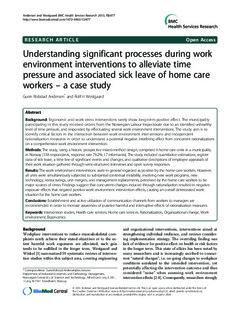| dc.contributor.author | Andersen, Gunn Robstad | |
| dc.contributor.author | Westgaard, Rolf Harald | |
| dc.date.accessioned | 2015-01-06T07:35:46Z | |
| dc.date.accessioned | 2016-04-27T14:17:17Z | |
| dc.date.available | 2015-01-06T07:35:46Z | |
| dc.date.available | 2016-04-27T14:17:17Z | |
| dc.date.issued | 2013 | |
| dc.identifier.citation | BMC Health Services Research 2013, 13(477) | nb_NO |
| dc.identifier.issn | 1472-6963 | |
| dc.identifier.uri | http://hdl.handle.net/11250/2387663 | |
| dc.description.abstract | Background: Ergonomic and work stress interventions rarely show long-term positive effect. The municipality
participating in this study received orders from the Norwegian Labour Inspectorate due to an identified unhealthy
level of time pressure, and responded by effectuating several work environment interventions. The study aim is to
identify critical factors in the interaction between work environment interventions and independent
rationalization measures in order to understand a potential negative interfering effect from concurrent rationalizations
on a comprehensive work environment intervention.
Methods: The study, using a historic prospectivemixed-method design, comprised 6 home care units in a municipality
in Norway (138 respondents, response rate 76.2%; 17 informants). The study included quantitative estimations, register
data of sick leave, a time line of significant events and changes, and qualitative descriptions of employee appraisals of
their work situation gathered through semi-structured interviews and open survey responses.
Results: The work environment interventions were in general regarded as positive by the home care workers. However,
all units were simultaneously subjected to substantial contextual instability, involving new work programs, new
technology, restructurings, unit mergers, and management replacements, perceived by the home care workers to be
major sources of stress. Findings suggest that concurrent changes induced through rationalization resulted in negative
exposure effects that negated positive work environment intervention effects, causing an overall deteriorated work
situation for the home care workers.
Conclusions: Establishment and active utilization of communication channels from workers to managers are
recommended in order to increase awareness of putative harmful and interruptive effects of rationalization measures. | nb_NO |
| dc.language.iso | eng | nb_NO |
| dc.publisher | BioMed Central | nb_NO |
| dc.rights | Navngivelse 3.0 Norge | * |
| dc.rights.uri | http://creativecommons.org/licenses/by/3.0/no/ | * |
| dc.title | Understanding significant processes during work environment interventions to alleviate time pressure and associated sick leave of home care workers - a case study | nb_NO |
| dc.type | Journal article | nb_NO |
| dc.type | Peer reviewed | nb_NO |
| dc.date.updated | 2015-01-06T07:35:46Z | |
| dc.source.volume | 13 | nb_NO |
| dc.source.journal | BMC Health Services Research | nb_NO |
| dc.identifier.doi | 10.1186/1472-6963-13-477 | |
| dc.identifier.cristin | 1067383 | |
| dc.description.localcode | © Andersen and Westgaard; licensee BioMed Central Ltd. 2013. This article is published under license to BioMed Central Ltd. This is an open access article distributed under the terms of the Creative Commons Attribution License (http://creativecommons.org/licenses/by/2.0), which permits unrestricted use, distribution, and reproduction in any medium, provided the original work is properly cited. | nb_NO |

